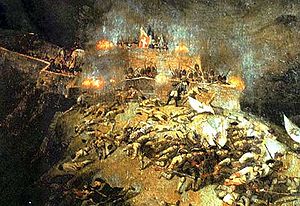Battle of the Assietta
| date | July 19, 1747 |
|---|---|
| place | Colle dell'Assietta, west of Turin |
| output | Retreat of the French, victory of the Sardinians |
| Parties to the conflict | |
|---|---|
| Commander | |
| Troop strength | |
| 32 battalions - 40,000 men | 13 battalions - 7,000 men |
| losses | |
|
4,000 dead and wounded, 600 prisoners |
400 dead |
The battle of the Colle dell'Assietta was fought on July 19, 1747 during the War of the Austrian Succession in the Alps west of Turin .
background
France had tried several times during the war to invade Sardinia-Piedmont . At Madonna dell'Olmo, the French and Spaniards had achieved a narrow initial success on September 30, 1744, but then failed at the siege of Cuneo . Something similar happened exactly one year later, when 60,000 French and Spaniards against 20,000 Piedmontese Karl Emanuels III. again narrowly won, but then lost in March 1746 at Asti and Alessandria (the Austrians, who had come too late at Bassignana, then won under Liechtenstein in June 1746 at Piacenza ). 1747 ordered Louis XV. a decisive attack on Piedmont . The 50 battalions made available for this purpose , led by the French General Belle-Isle and the Spanish Marques de las Minas, were to attack from the south and besiege Genoa ( a popular uprising had broken out there after an incident between Austrian soldiers and a boy named Balilla ) , as well as advance across the Alps towards Turin .
Course of the battle
After the attack in the south had not achieved the desired results, the French shifted their center of gravity further north and tried with strong infantry forces and associated cavalry and artillery over the Mont Cenis to Exilles and over the Assietta heights to Fenestrelle .
Since Charles Emanuel III. of Savoy anticipated this French train, he ordered an expansion of the Piedmontese positions on the 2,500 m high Colle dell'Assietta, which were occupied by a total of 13 battalions . These forces included a number of Swiss mercenaries and four battalions of the allied Austrians. Since French scouts had observed the preparatory work of the Piedmontese, the French leadership ordered an immediate attack by the 32 battalions available here. On the right French side (de Villemur) 14 battalions were to attack the Grand Serin, on the left ( Mailly ) 9 battalions the positions near Riobacon, in the middle (d'Arnault) 8 battalions the Assietta Heights.
The attack began on July 19, 1747 at 4:30 p.m. Both on the Assietta Heights and on the Serano, the nine Piedmontese and four Austrian battalions threw back the French units. The French generals led their troops very energetically on the front line. Belle Isle's younger brother lost his life while leading an attack with a flag in hand. D'Arnault also fell during the fierce fighting. Although the French lost their commander, they continued to attack. Over the Serano, held by a few Piedmontese, they tried to take the Assieta positions, but failed and were then defeated there by the reserves of the Count of Bricherasio . After five hours of heavy fighting, the French finally withdrew.
consequences
France had 4,000 dead and wounded after the battle, and 600 soldiers were taken prisoner. Piedmontese and Austrians lost 400 men. The attempt to force the Piedmontese out of the war had failed. At the Peace of Aachen , Sardinia-Piedmont received smaller areas on Lake Maggiore . The borders of Piedmont then remained unchanged until 1859.
literature
- Mauro Minola: Assietta. Tutta la storia dal XVI secolo ad oggi. Susalibri, Sant'Ambrogio di Torino 2006. ISBN 978-88-88916-43-9
- Marco Boglione: Le Strade militari dell'Assietta. Storia, itinerari, fortificazioni. Blu Edizioni, Turin 2006. ISBN 88-7904-017-0
